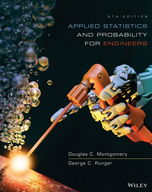Solution Found!
Consider the endothermic reactions in Exercise 3-32. A
Chapter 3, Problem 114E(choose chapter or problem)
Consider the endothermic reactions in Exercise 3-32. A total of 20 independent reactions are to be conducted.
(a) What is the probability that exactly 12 reactions result in a final temperature less than 272 K?
(b) What is the probability that at least 19 reactions result in a final temperature less than 272 K?
(c) What is the probability that at least 18 reactions result in a final temperature less than 272 K?
(d) What is the expected number of reactions that result in a final temperature of less than 272 K?
Questions & Answers
QUESTION:
Consider the endothermic reactions in Exercise 3-32. A total of 20 independent reactions are to be conducted.
(a) What is the probability that exactly 12 reactions result in a final temperature less than 272 K?
(b) What is the probability that at least 19 reactions result in a final temperature less than 272 K?
(c) What is the probability that at least 18 reactions result in a final temperature less than 272 K?
(d) What is the expected number of reactions that result in a final temperature of less than 272 K?
ANSWER:Answer
Step 1 of 4
(a)
Consider the endothermic reactions in given below the table.
A total of independent reactions is to be conducted.
Final Temperature Conditions |
Number of Reactions |
266 K |
48 |
271 K |
60 |
274 K |
92 |
We are asked to find the probability that exactly reactions result in a final temperature less than
.
Hence the probability mass function PMF is according to the definition of PMF present in the table given below.
Final Temperature Conditions |
Number of Reactions |
PMF |
266 K |
48 |
|
271 K |
60 |
|
274 K |
92 |
Let denote the number of the reactions result in a final temperature less than
.
We need to find
Hence follows a binomial distribution which we can write,
The random variable that equals the number of trials that result in a success is a binomial random variable with parameters
The probability mass function (PMF) of is,
………………(1)
The probability that the reactions result in a final temperature less than
is from the table,
We have given
Hence the substitute the above values into equation (1),
Hence the probability that exactly reactions result in a final temperature less than
is
